The Old Hollywood-Inspired, Period-Authentic Costumes in 'Rebecca' Feel Exceptionally Modern
"It was the idea that anyone literally could go out now and buy Lily's outfit," says costume designer Julian Day, about Lily James's late-'30s pantsuit and cottage-core aesthetic.
Warning: Mild spoilers for 'Rebecca' below.
Like the source material, the Netflix adaptation of the Daphne du Maurier novel "Rebecca" takes place around 1938. But the unnamed protagonist, played by Lily James, looks like she walked out of a Fall 2020 country-chic, #cottagecore fashion editorial. Of course, the mystery thriller hidden in a romance has proven to be a timeless story that's continuously adapted for stage and screen (including Alfred Hitchcock's Oscar-winning 1940 film).
"I wanted to make sure a modern audience could understand these clothes, rather than be pushed away from them," explains costume designer, Julian Day, on a call. "Even though it's period correct, it was the idea that anyone literally could go out now and buy Lily's outfit — or Armie's outfit."
To maintain authenticity to the late '30s, Day referenced fashion and beachwear photography and took inspiration from Old Hollywood and style icons of the era. But the costume designer — who's also stunned audiences with his work on "Bohemian Rhapsody" and "Rocketman — also points out that contemporary fashion regularly mines that specific decade for inspiration.
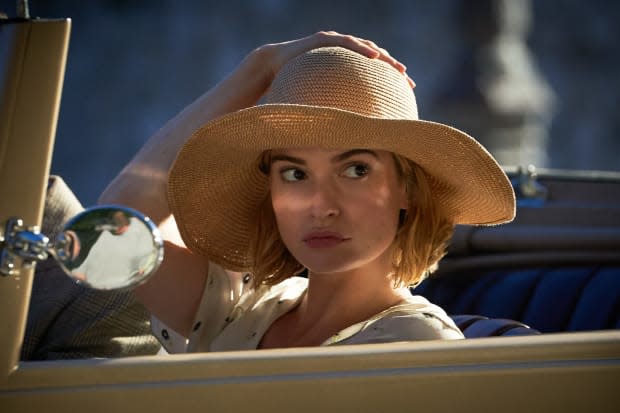
While working as a lady's maid on a glamorous jaunt to Monte Carlo, a restless, young and naive woman (James) meets a charming, enigmatic widower, Maxim de Winter (Armie Hammer). After a whirlwind romance in the South of France, they marry and settle back on the sprawling de Winter family estate, Manderley. But the new Mrs. de Winter — as James's character is named in the credits — can't escape the figurative ghost and dominating influence of her predecessor, Rebecca. And the intrigue begins.
But setting off her character's costume journey, James first appears in a drab brown skirtsuit, toiling away as her rich boss enjoys the life of leisure in glamorous Monte Carlo.
"She's in this dowdy hand-me-down wooly suit that's not very fashionable, even though Lily, as always, makes everything look good," says Day.
She catches the attention of Maxim, who spends the majority of his leisure time in Monte Carlo wearing a rakish three-piece marigold linen suit (below). Day custom-designed the ensemble, not just to accommodate Hammer's 6' 5" height, but also to represent the character as "a great golden trophy."
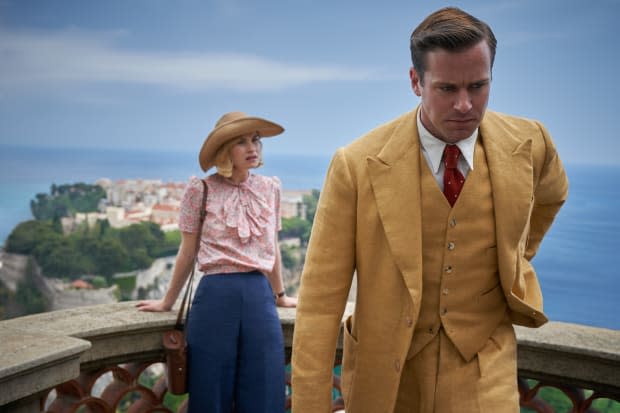
After their meet-cute, Maxim invites her on a stunning, winding "To Catch a Thief"-like drive up the French Riviera. She brightens up for the occasion in a pink puff-sleeved blouse with a cascade collar, wide-leg dark jeans and a floppy raffia hat (above). Her look was inspired by Silver Screen legends Katharine Hepburn, Greta Garbo and Marlene Dietrich, who were also groundbreaking fashion icons for pioneering menswear styles and wearing pants in the '30s.
"At the time, [wearing trousers] was quite revolutionary," explains Day. "People would stare at women in trousers. It was really only used for things like sports and things like that. So that idea of the south of France being very forward-thinking in its fashion style."
The softening into delicate prints, ethereal pastels and girlish collars — along with the denim she repeats — establish her signature.
"With the blossoming of her relationship with Maxim, I wanted to change her silhouette and introduce lots of lovely floral patterns and nice soft delicate cottons, silks and linens," Day, who custom-designed most of her looks based off of vintage pieces he sourced in Paris and England, notes. "Something that would give movement and freedom and the idea that this relationship was flowing between them. Very romantic shapes with the big ruffles, the big straw hats, and sunglasses and wide palazzo pants."
Day also took inspiration for the story's strong female protagonist from Coco Chanel, who changed the fashion landscape with her corset-free, sports- and menswear-inspired silhouettes. So, it's fitting that he dresses James in a vintage cream and blue-piped Chanel cardigan — layered over a red, white and blue halter bathing suit and jeans — for a steamy excursion.
"Ultimately, Lily's character wouldn't have been able to afford that cardigan in real life," says Day. "But, there was just something about it. I was allowed to take the buttons off and replace them with non-logo-ed buttons."

For the newlyweds' drive to Manderley, Maxim still wears his golden suit under an overcoat, while the now-Mrs. de Winter arrives bundled up in a gray collarless wrap-front coat and azure blue beret, reminiscent of the Mediterranean waters off Monte Carlo (above). (She removes the topper fit for the English countryside climate to reveal her blue floral "summer dress.")
"I wanted to almost see them as being out of place in this manor. It's raining and they come from this beautiful sunshine in the South of France. I wanted them to feel incongruous within the walls of Manderley," says Day. "Maxim arrives in his golden summer suit, and then immediately changes into his more country look."
Fun fact: Production designer Sarah Greenwood actually used a combination of eight different country houses and estates all over England to create the fictional Manderley. The disparate, distinct architecture and décor, also from varying time periods, further enhance the new Mrs. de Winter's and the audience's disorientation.
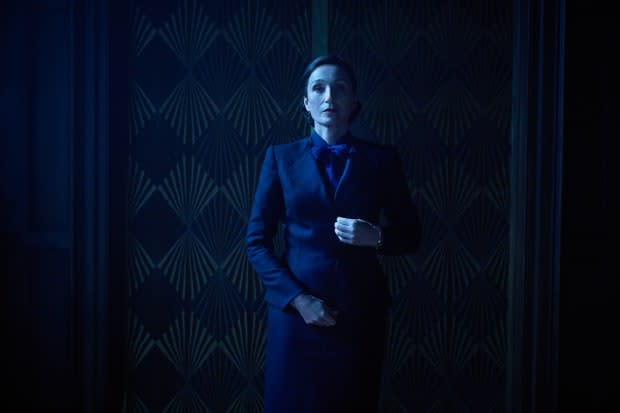
Mrs. Danvers (Kristen Scott Thomas, above), Manderley's incredibly imposing and chic housekeeper, doesn't help the new lady of the manor settle in, either.
"This austere, distinct character that puts the fear of god in her," says Day, who custom-built Mrs. Danvers's ultra-tailored dark skirt suit uniform with a "slightly dominatrix-like vibe."
"I came up with this idea of her blouse was a representation of a bruise, it was like a bruise of Manderley," he adds. Throughout the movie, he transitioned the colors of Mrs. Danvers's silk chiffon pussy bow tops from blue to maroon to ochre.
As Mrs. de Winter attempts to make a new home for herself, she discovers more about Rebecca, even though Maxim refuses to discuss his late wife. During one of the couple's scenic walks along the seaside cliffs, she intrepidly wanders into an abandoned boat house, while wearing a ruggedly elegant gray wool pantsuit (below).
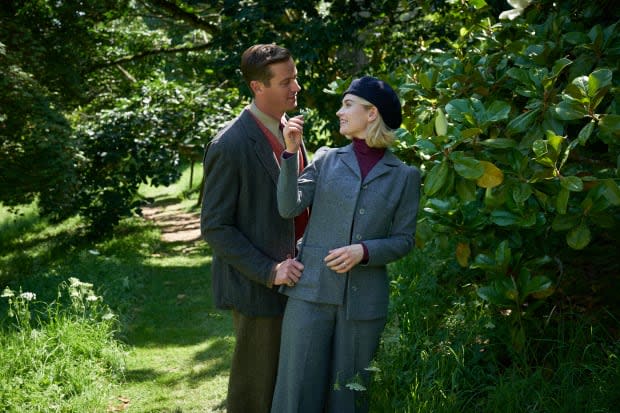
Day based her menswear-style outfit, topped off with a jaunty knit beret, on a famous 1933 photo of a DGAF Marlene Dietrich in Hollywood. "This strong, female character — really, [the inspiration is] quite simple," he explains. (The costume designer also used tailoring to transform Margot Robbie into a '40s noir femme fatale in the 2018 thriller "Terminal.")
Related Articles:
The Costumes in 'Bohemian Rhapsody' Help Rami Malek Victoriously Transform Into Freddie Mercury
How Fashion Transforms Margot Robbie Into a Femme Fatale Through the Ages in New Thriller 'Terminal'
Millie Bobby Brown's Victorian Teen Detective Costumes in 'Enola Holmes' Speak to the 20th Century Women's Rights Movement
Mrs. de Winter repeats her wardrobe favorites, including those first date wide-leg jeans and the puff-shoulder blazer, which she later wears with a blue, grey and cream crochet-knit sweater (below). When she enters Rebecca's forbidden bedroom — which Mrs. Danvers keeps as an almost-shrine — the colors of her top coordinate with the icy blues and silvers of the wallpaper-covered, mirrored space.
"I wanted her to almost disappear into it; being engulfed by the idea of Rebecca and what Rebecca stood for," Day says. He considered making her stand out in red or yellow, but opted for the camouflage idea instead. The fragile feel of the knit and rounded shapes of the pattern also counter all the sharp angles in the room.
"She wears it later on when she's outside," he continues. "We were filming in Dorset at the time, and the colors of the cliffs in Dorset are those colors. So it fit in perfectly."
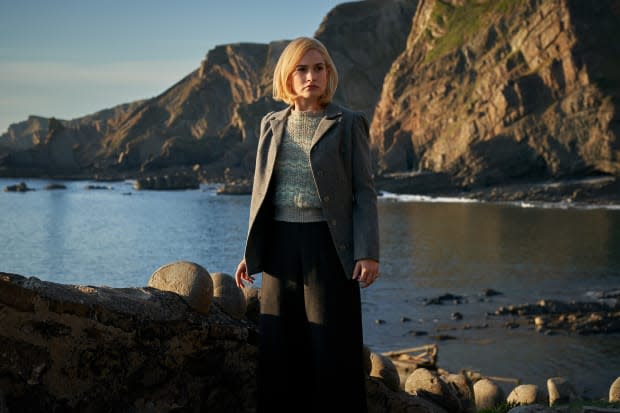
Mrs. de Winter's palette darkens and silhouettes streamline as she asserts herself at Manderley, though Rebecca still overshadows her attempts. She does, however, revert back to her earlier soft lines and pastels after a sort of fashion faux pas during her resurrection of the illustrious Manderley Ball. Sister-in-law Beatrice (Keely Hawes) snatches a slouchy watercolor floral midi-dress out of the wardrobe as a quick replacement for the distraught and humiliated Mrs. de Winter (below).
"Ultimately, I nicknamed that dress, 'the sad dress,'" says Day.
The pinks and purples and languid longline silhouette feel completely out of place as a distraught, tearful and confused Mrs. de Winter stumbles through the frenetic and dancing crowd clad in elaborate black tie costumes. Day custom-designed the "sad dress" based off of a '30s vintage piece, custom-printing the dreamy fabric.
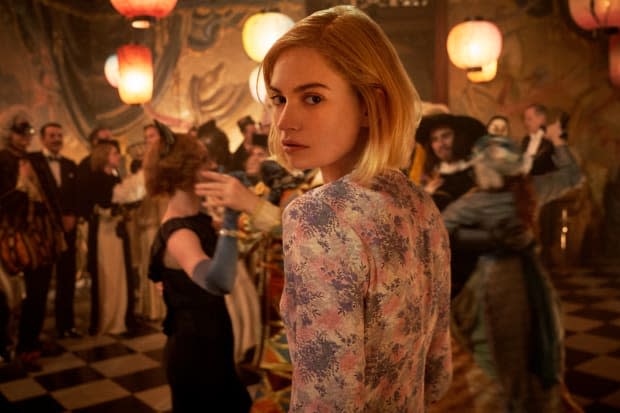
"Ironically, [the sad dress] was Lily's favorite dress throughout the whole film," says Day. "We had quite a few made and I gave her one at the end."
The de Winters eventually find their power dynamic shifting, and the new prevailing force finds her wardrobe elevating along with her confidence and self assurance. For the climactic finale moment, she dons a yellow bouclé suit (below), which, presumably, she now can actually afford.
"I was in Paris shopping and I found this vintage Chanel fabric and I looked at it and I was like, 'I've got to use that on something,'" Day remembers. "I bought a whole load of it — and it was incredibly expensive — but it was worth it."
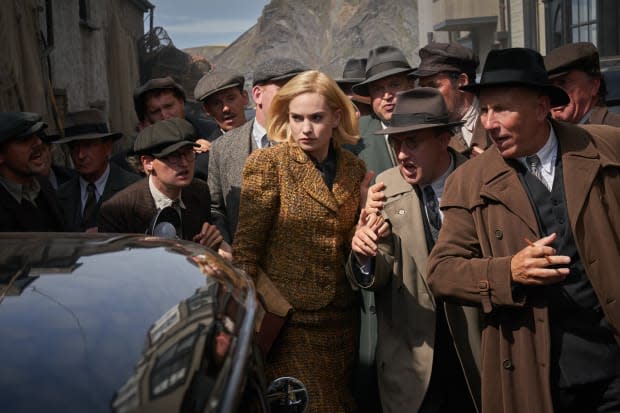
While determining when and how to use the precious fabric, he realized the mustard yellow spoke back to Maxim's golden suit in the beginning of the movie and would illustrate a cycle in the de Winter's relationship.
"The suit that Armie wears at the beginning was a representation of a golden statue, something that Lily's character aspires to become to get this trophy," explains Day. "It's a role reversal. At the end of the film, she's this strong powerful savior."
Never miss the latest fashion industry news. Sign up for the Fashionista daily newsletter.

 Yahoo News
Yahoo News 